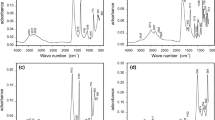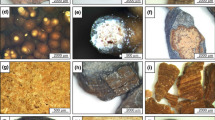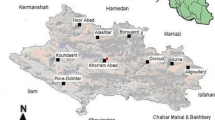Abstract
This study describes the primary characteristics of the selected kidney stones surgically removed from the patients at the Mersin University Hospital in the southern Turkey and interprets their formation via petrographic, geochemical, XRD, SEM–EDX, and ICP-MS/OES analyses. The analytical results revealed that the kidney stones are composed of the minerals whewellite, struvite, hydroxyapatite, and uric acid alone or in different combinations. The samples occur in staghorn, bean-shaped composite, and individual rounded particle shapes, which are controlled by the shape of the nucleus and the site of stone formation. The cross-section of the samples shows concentric growth layers due to variations in saturation, characterizing the metastable phase. Kidney stone formation includes two main stages: (i) nucleation and (ii) aggregation and/or growth. Nucleation was either Randall plaque of hydroxyapatite in tissue on the surface of the papilla or a coating of whewellite on the plaque, or crystallization as free particles in the urine. Subsequently, aggregation or growth occurs by precipitation of stone-forming materials around the plaque or coating carried into the urine, or around the nucleus formed in situ in the urine. Urinary supersaturation is the main driving force of crystallization processes; and is controlled by many factors including bacterially induced supersaturation.





Similar content being viewed by others
References
Abboud, I. A. (2008). Mineralogy and chemistry of urinary stones: Patients from North Jordan. Environmental Geochemistry and Health, 30, 445–463. https://doi.org/10.1007/s10653-007-9128-7
Afaj, A. H., & Sultan, M. A. (2005). Mineralogical composition of the urinary stones from different provinces in Iraq. The Scientific World Journal, 5, 24–38. https://doi.org/10.1100/tsw.2005.2
Ahmed, S., Hasan, M. M., & Mahmood, Z. A. (2017). Urolithiasis in gel: An in vitro approach for Whewellite growth patterns to evaluate risk factors and management of urinary stones. Journal of Pharmacognosy and Phytochemistry, 6(2), 87–91.
Aissaoui, D. M. (1985). Botryoidal aragonite and its diagenesis. Sedimentology, 32(3), 345–361. https://doi.org/10.1111/j.1365-3091.1985.tb00516.x
Alelign, T., & Petros, B. (2018). Kidney stone disease: an update on current concepts. Advances in Urology, 3068365. https://doi.org/10.1155/2018/3068365
Asplin, J. R. (2014). Metabolic evaluation: interpretation of 24-Hour urine chemistries. In: M. Grasso, & D. S. Goldfarb (Eds.), Urinary Stones: Medical and Surgical Management (1st ed., pp. 13–25). Wiley.
Bhatt, P. A., & Paul, P. (2008). Analysis of urinary stone constituents using powder X-ray diffraction and FT–IR. Journal of Chemical Sciences, 120(2), 267–273. https://doi.org/10.1007/S12039-008-0032-1
Bichler, K. H., Eipper, E., Naber, K., Braun, V., Zimmermann, R., & Lahme, S. (2002). Urinary infection stones. International Journal of Antimicrobial Agents, 19, 488–498. https://doi.org/10.1016/s0924-8579(02)00088-2
Carvalho, M. (2018). Urinary pH in calcium oxalate stone formers: Does it matter? Brazilian Journal of Nephrology, 40(1), 6–7. https://doi.org/10.1590/1678-4685-JBN-2018-00010002
Chandrajith, R., Weerasingha, A., Premaratne, K. M., Gamage, D., Abeygunasekera, A. M., Joachimski, M. M., & Senaratne, A. (2019). Mineralogical, compositional and isotope characterization of human kidney stones (urolithiasis) in a Sri Lankan population. Environmental Geochemistry and Health, 41, 1881–1894. https://doi.org/10.1007/s10653-018-0237-2
Çiftçioğlu, N., Björklund, M., Kuorikoski, K., Bergström, K., & Kajander, E. O. (1999). Nanobacteria: An infectious cause for kidney stone formation. Kidney International, 56, 1893–1898. https://doi.org/10.1046/j.1523-1755.1999.00755.x
Cloutier, J., Villa, L., Traxer, O., & Dauton, M. (2015). Kidney stone analysis: “Give me your stone, I will tell you who you are!” World Journal of Urology, 33, 157–169. https://doi.org/10.1007/s00345-014-1444-9
Dawson, C. H. (2012). Kidney stone disease: Pathophysiology, investigation and medical treatment. Clinical Medicine, 12(5), 467–471. https://doi.org/10.7861/clinmedicine.12-5-467
Didenko, L. V., Tolordava, E. R., Perpanova, T. S., Shevlyagina, N. V., Borovaya, T. G., Romanova, Y. M., Cazzaniga, M., Curia, R., Milani, M., Savoia, C., & Tatti, F. (2014). Electron Microscopy Investigation of Urine Stones suggests how to prevent Post-operation Septic Complications in Nephrolithiasis. Journal of Applied Medical Sciences, 3(4), 19–34.
Eisner, B. H., Deshmukh, S. M., & Lange, D. (2014). Struvite stones. In: M. Grasso, & D. S. Goldfarb (Eds.), Urinary Stones: Medical and Surgical Management (1st Ed., pp. 48–55). Wiley.
Evan, A. P. (2010). Physiopathology and etiology of stone formation in the kidney and the urinary tract. Pediatric Nephrology, 25, 831–841. https://doi.org/10.1007/s00467-009-1116-y
Flannigan, R., Choy, W. H., Chew, B., & Lange, D. (2014). Renal struvite stones–pathogenesis, microbiology, and management strategies. Nature Reviews Urology, 11, 333–341. https://doi.org/10.1038/nrurol.2014.99
Gandhi, K. R., & Chavan, S. (2019). Revisiting the morphology of pelvicalyceal system in human cadaveric kidneys with a systematic review of literature. Asian Journal of Urology, 6, 249–255. https://doi.org/10.1016/j.ajur.2018.12.006
George, A., & Veis, A. (2008). Phosphorylated proteins and control over apatite nucleation, crystal growth, and inhibition. Chemical Reviews, 108, 4670–4693. https://doi.org/10.1021/cr0782729
Giannossi, M. L., Mongelli, G., Tateo, F., & Summa, V. (2012). Mineralogical and morphological investigation of kidney stones of a Mediterranean region (Basilicata, Italy). Journal of X-Ray Science and Technology, 20, 175–186. https://doi.org/10.3233/XST-2012-0327
Goldfarb, D. S. (2012). A woman with recurrent calcium phosphate kidney stones. Clinical Journal of the American Society of Nephrology, 7, 1172–1178. https://doi.org/10.2215/CJN.00560112
Grases, F., Costa-Bauzá, A., & García-Ferragut, L. (1998). Biopathological crystallization: A general view about the mechanisms of renal stone formation. Advances in Colloid and Interface Science, 74, 169–194. https://doi.org/10.1016/s0001-8686(97)00041-9
Grases, F., Söhnel, O., & Gomila, I. (2013). Structure and composition of non-infectious phosphate calculi formed in patients with low and high urinary phosphate concentrations. Open Journal of Urology, 3, 12–20. https://doi.org/10.4236/oju.2013.31003
Hesse, A. (2009). Urinary stones. In F. Lang (Ed.), Encyclopedia of molecular mechanisms of disease, Springer-Verlag, pp. 2144–2147.
Hill, M. G., Königsberger, E., & May, P. M. (2017). Mineral precipitation and dissolution in the kidney. American Mineralogist, 102, 701–710. https://doi.org/10.2138/am-2017-5778
Hövelmann, J., Stawski, T. M., Freeman, H. M., & Besselink, R. (2019a). Struvite crystallisation and the effect of Co2+ ions. Minerals, 9, 503. https://doi.org/10.3390/min9090503
Hövelmann, J., Stawski, T. M., Besselink, R., Freeman, H. M., Dietmann, K. M., Mayanna, S., Pauw, B. R., & Benning, L. G. (2019b). A template-free and low temperature method for the synthesis of mesoporous magnesium phosphate with uniform pore structure and high surface area. Nanoscale, 11, 6939–6951. https://doi.org/10.1039/c8nr09205b
Ivanovski, O., & Drüeke, T. B. (2013). A new era in the treatment of calcium oxalate stones? Kidney International, 83, 998–1000. https://doi.org/10.1038/ki.2013.41
Kajander, E. O., & Çiftçioğlu, N. (1998). Nanobacteria: An alternative mechanism for pathogenic intra- and extracellular calcification and stone formation. Proceedings of the National Academy of Sciences of the United States of America, 95, 8274–8279. https://doi.org/10.1073/pnas.95.14.8274
Keshavarzi, B., Yavarashayeri, N., Irani, D., Moore, F., Zarasvandi, A., & Salari, M. (2015). Trace elements in urinary stones: A preliminary investigation in Fars province. Iran. Environmental Geochemistry and Health, 37(2), 377–389. https://doi.org/10.1007/s10653-014-9654-z
Keshavarzi, B., Ashayeri, N. Y., Moore, F., Irani, D., Asadi, S., Zarasvandi, A., & Salari, M. (2016). Mineralogical composition of urinary stones and their frequency in patients: Relationship to gender and age. Primer, Minerals, 6(4), 131. https://doi.org/10.3390/min6040131
Khalili, P., Jamali, Z., Sadeghi, T., Esmaeili-nadimi, A., Mohamadi, M., Moghadam-Ahmadi, A., Ayoobi, F., & Nazari, A. (2021). Risk factors of kidney stone disease: A cross-sectional study in the southeast of Iran. BMC Urology, 21, 141. https://doi.org/10.1186/s12894-021-00905-5
Khan, R. S. (2021). Inflammation and injury: What role do they play in the development of Randall’s plaques and formation of calcium oxalate kidney stones? Comptes Rendus Chmie, 25(S1), 1–19. https://doi.org/10.5802/crchim.93
Khan, S. R., Pearle, M. S., Robertson, W. G., Gambora, G., Canales, B. K., Doizi, S., Traxer, O., & Tiselius, H. G. (2016). Kidney stones. Nature Reviews Disease Primers, 2, 16008. https://doi.org/10.1038/nrdp.2016.8
Khan, F., Haider, M.F., Singh, M.K., Sharma, P., Kumar, T., & Neda, E.N. (2019). A comprehensive review on kidney stones, its diagnosis and treatment with allopathic and ayurvedic medicines. Urology and Nephrology Open Access Journal, 7(4), 69–74. https://doi.org/10.15406/unoaj.2019.07.00247
Knoll, T. (2010). Epidemiology, pathogenesis, and pathophysiology of urolithiasis. European Urology Supplements, 9(12), 802–806. https://doi.org/10.1016/j.eursup.2010.11.006
Krambeck, A. E., Handa, S. E., Evan, A. P., & Lingeman, J. E. (2010). Profile of the brushite stone former. Journal in Urology, 184(4), 1367–1371. https://doi.org/10.1016/j.juro.2010.05.094
Kramer, G., Klingler, H. C., & Steiner, G. (2000). Role of bacteria in the development of kidney stones. Current Opinion in Urology, 10(1), 35–38. https://doi.org/10.1097/00042307-200001000-00009
Krieger, N. S., Asplin, J. R., Frick, K. K., Granja, I., Culbertson, C. D., Ng, A., Grynpas, M. D., & Bushinsky, D. A. (2015). Effect of potassium citrate on calcium phosphate stones in a model of hypercalciuria. Journal of the American Society of Nephrology, 26(12), 3001–3008. https://doi.org/10.1681/ASN.2014121223
Lenton, S., Wang, Q., Nylander, T., Teixeria, S., & Holt, C. (2020). Structural biology of calcium phosphate nanoclusters sequestered by phosphoproteins. Crystals, 10(9), 755. https://doi.org/10.3390/cryst10090755
Letavernier, E., Bazin, D., & Daudon, M. (2016). Randall’s plaque and kidney stones: Recent advances and future challenges. Comptes Rendus Chimie, 19, 1456–1460. https://doi.org/10.1016/j.crci.2014.12.005
Li, H., Yu, S. H., Yao, Q. Z., Zhou, G. T., & Fu, S. Q. (2015). Chemical control of struvite scale by a green inhibitor polyaspartic acid. RSC Advances, 5, 91601–91608. https://doi.org/10.1039/c5ra17149k
Lieske, J. C. (2014). Calcium stones. In: M. Grasso, & D. S. Goldfarb, (Eds.), Urinary stones: medical and surgical management (1st Ed., pp. 36–47). Wiley.
Liu, Y., Qu, M., Carter, R. E., Leng, S., Ramirez-Giraldo, J. C., Jaramillo, G., Krambeck, A. E., Lieske, J. C., Vrtiska, T. J., & McCollough, C. H. (2013). Differentiating calcium oxalate and hydroxyapatite stones in vivo using dual-energy CT and urine supersaturation and pH values. Academic Radiology, 20(12), 1521–1525. https://doi.org/10.1016/j.acra.2013.08.018
Lobo, M. L. P., Favorito, L. A., Abidu-Figueiredo, M., & Sampaio, F. J. B. (2011). Renal pelvic diameters in human fetuses: Anatomical reference for diagnosis of fetal hydronephrosis. Urology, 77, 452–457. https://doi.org/10.1016/j.urology.2010.06.049
Manissorn, J., Fong-ngern, K., Peerapen, P., & Thongboonkerd, V. (2017). Systematic evaluation for effects of urine pH on calcium oxalate crystallization, crystal-cell adhesion and internalization into renal tubular cells. Scientific Reports, 7, 1798. https://doi.org/10.1038/s41598-017-01953-4
Manzoor, M. A. P., Singh, B., Agrawal, A. K., Arun, A. B., Mujeeburahiman, M., Rekha, P-D. (2018). Morphological and micro-tomographic study on evolution of struvite in synthetic urine infected with bacteria and investigation of its pathological biomineralization. Plos One, 13(8), e0202306. https://doi.org/10.1371/journal.pone.0202306
Maurice-Estepa, L., Levillain, P., Lacour, B., & Daudon, M. (1999). Crystalline phase differentiation in urinary calcium phosphate and magnesium phosphate calculi. Scandinavian Journal of Urology, 88, 299–305. https://doi.org/10.1080/003655999750017365
McLean, R. J. C., & Brown, E. T. (2020). Potential influences of bacterial cell surfaces and nano-sized cell fragments on struvite biomineralization. Crystals, 10, 706. https://doi.org/10.3390/cryst10080706
Mukherjee, A. K. (2014). Human Kidney stone analysis using X-ray powder diffraction. Journal of the Indian Institute of Science, 94(1), 35–44.
Orlando, M. T. D., Kuplich, L., Souza, D. O., Belich, H., Depianti, J. B., Orlando, C. G. P., Medeiros, E. F., Da Cruz, P. C. M., Martinez, L. G., Corrêa, H. P. S., & Ortiz, R. (2008). Study of calcium oxalate monohydrate of kidney stones by X-ray diffraction. Powder Diffraction, 23(S1), S59–S64. https://doi.org/10.1154/1.2903738
Pramanik, R., Asplin, J. R., Jackson, M. E., & Williams, J. C. (2008). Protein content of human apatite and brushite kidney stones: Significant correlation with morphologic measures. Urological Research, 36(5), 251–258. https://doi.org/10.1007/s00240-008-0151-7
Prien, E. L., & Frondel, C. (1947). Studies in urolithiasis; the composition of urinary calculi. Journal of Urology, 57(6), 949–994. https://doi.org/10.1016/s0022-5347(17)69732-5
Prywer, J., Torzewska, A., & Płociński, T. (2012). Unique surface and internal structure of struvite crystals formed by Proteus mirabilis. Urological Research, 40, 699–707. https://doi.org/10.1007/s00240-012-0501-3
Prywer, J., Sadowski, R. R., & Torzewska, A. (2015). Aggregation of struvite, carbonate apatite, and Proteus mirabilis as a key factor of infectious urinary stone formation. Crystal Growth Design, 15(3), 1446–1451. https://doi.org/10.1021/cg5018032
Racek, M., Racek, J., & Hupáková, I. (2019). Scanning electron microscopy in analysis of urinary stones. Scandinavian Journal of Clinical and Laboratory Investigation, 79(3), 208–217. https://doi.org/10.1080/00365513.2019.1578995
Ratkalkar, V. N., & Kleinman, J. G. (2011). Mechanisms of stone formation. Clinical Reviews in Bone and Mineral Metabolism, 9(3–4), 187–197. https://doi.org/10.1007/s12018-011-9104-8
Romero, V., Akpınar, H., & Assimos, D. G. (2010). Kidney stones: A global picture of prevalence, incidence, and associated risk factors. Reviews in Urology, 12(2/3), e86–e96. https://doi.org/10.3909/riu0459
Sarıkaya, S., Yücel, Ç., Karşıyakalı, N., Sertoğlu, E., Kaya, E., Ebiloğlu, T., Bedir, S., & Özgürtaş, T. (2020). Analysis of urinary stone types’ distribution in Turkey according to the geographical regions where patients were born and live: A cross-sectional single-center experience. Gülhane Medical Journal, 62, 163–169. https://doi.org/10.4274/gulhane.galenos.2020.978
Silva, S. F. R., Matos, D. C., Silva, S. L., Daher, E. F., Campos, H. H., & Silva, C. A. B. (2010). Chemical and morphological analysis of kidney stones. A double-blind comparative study. Acta Cirúrgica Brasileira, 25(5), 444–448. https://doi.org/10.1590/s0102-86502010000500011
Singh, V. K., & Rai, P. K. (2014). Kidney stone analysis techniques and the role of major and trace elements on their pathogenesis: A review. Biophysical Reviews, 6, 291–310. https://doi.org/10.1007/s12551-014-0144-4
Titov, A. T., Larionov, P. M., Ivanova, A. S., Zaikovskii, V. I., & Chernyavskiy, M. A. (2016). Bone-like hydroxyapatite formation in human blood. International Journal of Environmental and Science Education, 11(10), 3971–3984.
Vervaet, B. A., Verhulst, A., D’Haese, P. C., & Broe, M. E. (2009). Nephrocalcinosis: New insights into mechanisms and consequences. Nephrology Dialysis Transplantation, 24, 2030–2035. https://doi.org/10.1093/ndt/gfp115
Wang, L., & Nancollas, G. H. (2009). Pathways to biomineralization and biodemineralization of calcium phosphates: The thermodynamic and kinetic controls. Dalton Transactions, 15(15), 2665–2672. https://doi.org/10.1039/b815887h
Wang, Z., Zhang, Y., Zhang, J., Deng, Q., & Liang, H. (2021). Recent advances on the mechanisms of kidney stone formation (Review). International Journal of Molecular Medicene, 48, 149. https://doi.org/10.3892/ijmm.2021.4982
Wiederkehr, M. R., & Moe, O. W. (2011). Uric acid nephrolithiasis: A systemic metabolic disorder. Clinical Reviews in Bone and Mineral Metabolism, 9(3–4), 207–217. https://doi.org/10.1007/s12018-011-9106-6
Wiener, S. V., Ho, S. P., & Stoller, M. L. (2018). Beginnings of nephrolithiasis: Insights into the past, present and future of Randall’s plaque formation research. Current Opinion in Nephrology and Hypertension, 27(4), 236–242. https://doi.org/10.1097/MNH.0000000000000414
Williams, J. C., Worcester, E., & Lingeman, J. E. (2016). What can the microstructure of stones tell us? Urolithiasis, 45(1), 19–25. https://doi.org/10.1007/s00240-016-0944-z
Young, J. D., Martel, J., Young, D., Young, A., Hung C-M, Young, L., Chao, Y-J., Young, J., & Wu, C-Y. (2009) Characterization of granulations of calcium and apatite in serum as pleomorphic mineralo-protein complexes and as precursors of putative nanobacteria. Plos One, 4(5): e5421. https://doi.org/10.1371/journal.pone.0005421
Zuckerman, J. M., & Assimos, D. G. (2009). Hypocitraturia: Pathophysiology and medical management. Reviews in Urology, 11(3), 134–144. https://doi.org/10.3909/riu0424
Acknowledgements
The authors are much indebted to the anonymous reviewers for their extremely careful and constructive reviews that improved the quality of the paper significantly. The authors are also extremely grateful to the Editor, Nour El-Gendy, for her insightful editorial comments and suggestions.
Funding
No funding was received for conducting this study.
Author information
Authors and Affiliations
Contributions
The authors, EE, YYK, ME, and SK, equally contributed to the writing of the article.
Corresponding author
Ethics declarations
Conflict of interest
There are no conflicts of interest.
Additional information
Publisher's Note
Springer Nature remains neutral with regard to jurisdictional claims in published maps and institutional affiliations.
Rights and permissions
Springer Nature or its licensor (e.g. a society or other partner) holds exclusive rights to this article under a publishing agreement with the author(s) or other rightsholder(s); author self-archiving of the accepted manuscript version of this article is solely governed by the terms of such publishing agreement and applicable law.
About this article
Cite this article
Eren, E., Karabulut, Y.Y., Eren, M. et al. Mineralogy, geochemistry, and micromorphology of human kidney stones (urolithiasis) from Mersin, the southern Turkey. Environ Geochem Health 45, 4761–4777 (2023). https://doi.org/10.1007/s10653-023-01525-8
Received:
Accepted:
Published:
Issue Date:
DOI: https://doi.org/10.1007/s10653-023-01525-8




